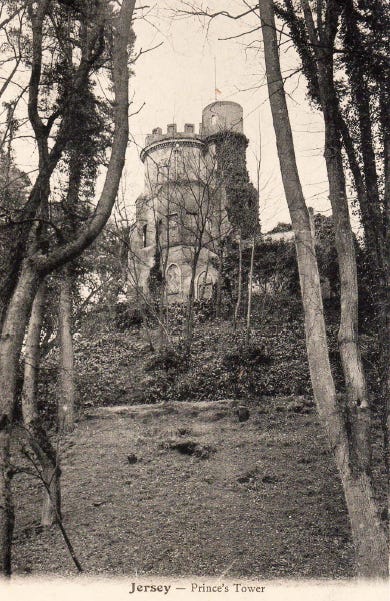Welcome to another episode of the History Islands, where we continue our tour of Jersey’s lost landmarks.
Let us turn east to the ancient site of La Hougue Bie, where in 1913, one of Jersey’s greatest monuments still stood, albeit in an advanced state of decay.
Its story begins with Philippe Dauvergne – an astonishingly charismatic and restless young man, born in 1754. He travels to the ends of the earth. He heads into the icy death zone of the Arctic, fighting polar bears, travelling with Horatio Nelson. As a young naval officer visiting Russia, Empress Catherine the Great tries to seduce him. In the American Revolution, he leads an attack on Long Island. He is present at the Battle of Bunker Hill, as the United States is born.
Then, in a surreal turn of events, he is held prisoner in a dungeon in Carhaix in France where, by a bizarre coincidence he comes to the attention of Godefroy de la Tour d’Auvergne, the Duc de Bouillon. The ruler of a dukedom in modern day Belgium, he is a libertine with no legitimate heir and is desperate for a worthy son he can bequeath his lands to.
The old duke is entranced by Philippe’s charm and his strikingly similar surname. He whisks his new protégé away to a palace in the forest in Brittany. Philippe somehow talks himself into inheriting a dukedom. In 1786, Dauvergne is formally offered the Dukedom of Bouillon, with the motto “Nous ne changeons pas: We do not change”. Now he calls himself D’Auvergne, in the French style.
We follow the story in this extract from my first book, Jersey: The Hidden Histories:
Here in Jersey, d’Auvergne decided to reconstruct the magical apparition of royalty that had once greeted him in the Breton forest. He took in hand the sacred, ancient site of La Hougue Bie, which stretched back into the dark era of prehistory, a place where legends are forged. It was ironically a former rival for the dukedom, Corret, who obsessed over druidic remains and first bequeathed the words menhir and dolmen to the language. The true heir to the throne of d’Auvergne had grander plans. Over the bones of the medieval chapel, he decided to construct an extraordinary Gothic fantasia. The locals soon dubbed it Prince’s Tower, and its spectacular turrets and battlements soared high above Jersey, taller than any other landmark.
From the fine heights of this flamboyant octagonal tower, all twelve parishes of Jersey unfurled at his feet like a green carpet. The Tower proved a capital signalling station, offering panoramic views of the enemy coast. Princely dinners and sumptuous wines were served in its dining hall. Meanwhile, the ancient Jerusalem chapel served as a fine library.
From this lofty vantage point, the prince-wizard surveyed the restless lives of scurrying mortals, spinning a web of intrigue across Europe, manipulating resistance and orchestrating sabotage. D’Auvergne’s efforts are in vain. His spies fail. Out of the chaos and bloodshed of the French Revolution, a new leader rises. In 1804, Napoleon Bonaparte crowns himself Emperor.
Meanwhile, in 1802, the invalid seventh Duke of Bouillon died and Philippe d’Auvergne at last assumed the mantle of ‘His Serene Highness’. The next year he followed in the footsteps of his old Arctic rival, Horatio Nelson, and was elevated to the prestigious title of Knight Grand Commander of the Order of St Joachim. The Jersey sailor-boy was now installed amongst the crown princes of Europe, and merely awaited the end of the war to claim his glorious prize. It seemed as if the fairy tale was drawing towards its final, magnificent chapter.
As late as 1815, D’Auvergne, the would-be prince, is still confident the Congress of Vienna will award him the duchy of Bouillon. He even has coins minted with his face on it. Meanwhile Napoleon returns to face ultimate defeat at Waterloo. When the Congress reconvenes, it rejects D’Auvergne’s claim. In the end, he receives neither the duchy, nor the estates, nor compensation. He has bankrupted himself in search of his dream.
In 1816, Philippe D’Auvergne dies in a squalid London hotel, his illusion shattered.
Prince’s Tower outlived its master, if only for a time. It became a curiosity, a Gothic pleasure-park boasting faux-medieval touches beloved of the sentimental Victorians. The Prince’s Tower Hotel opened in the grounds, serving high tea with fine views of this decaying folly. Black-clad children scampered in the gardens. Tourists marvelled and cooed at the vertiginous views. Yet eventually the Tower began to crumble and rot from the inside, a slowly decaying dream, falling back in to the ancient mound. Ivy consumed the shell.
Fashions changed, and soon the forgotten fantasias of princelings counted for little. In 1924 the Tower was deliberately and slowly razed to the ground, brick by brick. The turrets and battlements were reduced to charred rubble. The time of the Tower had passed, and the grassy mound of La Hougue Bie returned to the patient care of the ancients. In the words of Shelley, nothing beside remains. Only the little medieval chapel clung onto the summit like a tenacious prayer.
The dream vanished at daybreak, where the deep fields of Jersey slope down from all sides from the empty hill, cascading away towards the bright horizon. The sea still glimmers in the dawn light like a whispered, tantalising promise.
A much fuller version of Philippe D’Auvergne’s story is in Jersey: The Hidden Histories which is available from Amazon UK and WH Smith, Waterstones and the Harbour Gallery in Jersey.
Music: Chariots by Gavin Luke, courtesy of Epidemic Sound





